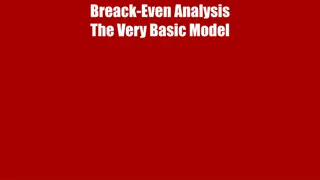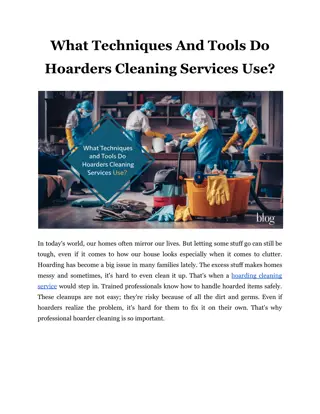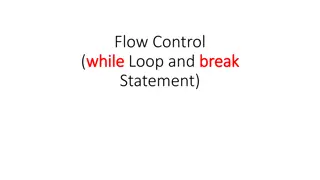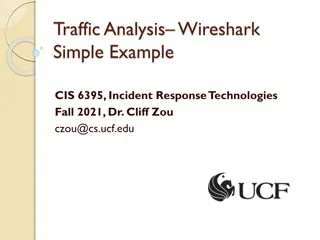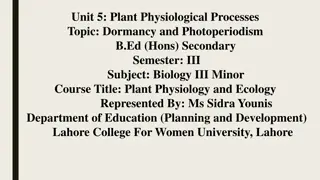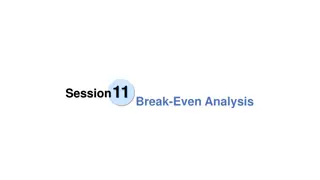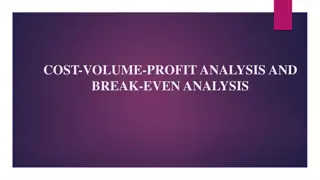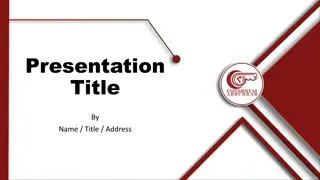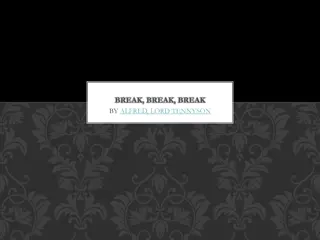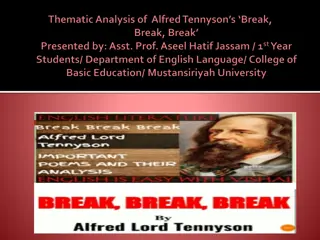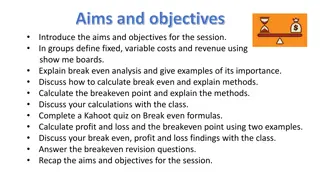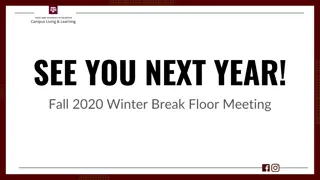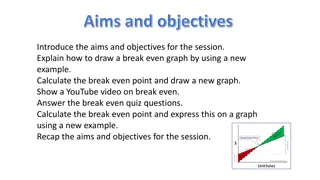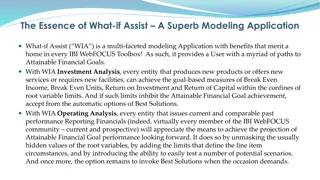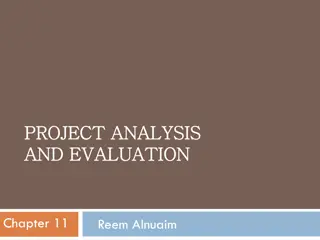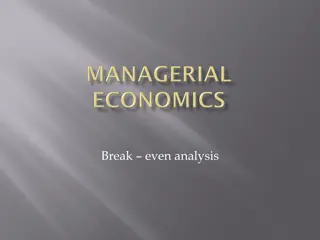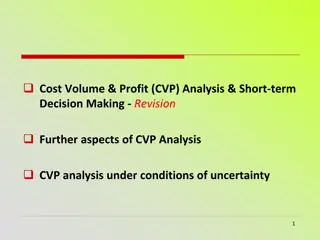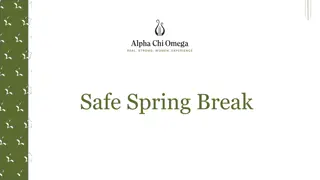Break-Even Analysis Techniques and Examples
Break-even analysis is a valuable technique used to evaluate process and equipment alternatives by determining the point at which costs equal revenue. This analysis involves estimating fixed costs, variable costs, and revenue to find the break-even point in both dollars and units. The difference between selling price and variable cost, known as contribution, plays a crucial role in this evaluation.
Download Presentation

Please find below an Image/Link to download the presentation.
The content on the website is provided AS IS for your information and personal use only. It may not be sold, licensed, or shared on other websites without obtaining consent from the author.If you encounter any issues during the download, it is possible that the publisher has removed the file from their server.
You are allowed to download the files provided on this website for personal or commercial use, subject to the condition that they are used lawfully. All files are the property of their respective owners.
The content on the website is provided AS IS for your information and personal use only. It may not be sold, licensed, or shared on other websites without obtaining consent from the author.
E N D
Presentation Transcript
Chapter 7s Class 2
Break-Even Analysis Technique for evaluating process and equipment alternatives Objective is to find the point in dollars and units at which cost equals revenue Requires estimation of fixed costs, variable costs, and revenue
Break-Even Analysis Fixed costs are costs that continue even if no units are produced Depreciation, taxes, debt, mortgage payments Variable costs are costs that vary with the volume of units produced Labor, materials, portion of utilities Contribution is the difference between selling price and variable cost
Break-Even Analysis Total revenue line 900 800 Total cost line Break-even point Total cost = Total revenue 700 600 Cost in dollars 500 Variable cost 400 300 200 100 Fixed cost | | | | | | | | | | | | 0 100 200 300 400 500 600 700 800 900 1000 1100 Volume (units per period) Figure S7.5
Break-Even Analysis BEPx = break-even point in units BEP$ = break-even point in dollars P = price per unit (after all discounts) x = number of units produced TR = total revenue = Px F = fixed costs V = variable cost per unit TC = total costs = F + Vx Break-even point occurs when TR = TC or Px = F + Vx F BEPx = P - V
Break-Even Analysis BEPx = break-even point in units BEP$ = break-even point in dollars P = price per unit (after all discounts) x = number of units produced TR = total revenue = Px F = fixed costs V = variable cost per unit TC = total costs = F + Vx BEP$ = BEPxP F Profit = TR - TC = Px - (F + Vx) = Px - F - Vx = (P - V)x - F = P P - V F = (P - V)/P F 1 - V/P =
Break-Even Example Fixed costs = $10,000 Direct labor = $1.50/unit Material = $.75/unit Selling price = $4.00 per unit $10,000 F BEP$ = = 1 - (V/P) 1 - [(1.50 + .75)/(4.00)] $10,000 = = $22,857.14 .4375 $10,000 F BEPx = = = 5,714 P - V 4.00 - (1.50 + .75)
Break-Even Example 50,000 Revenue 40,000 Break-even point Total costs 30,000 Dollars 20,000 Fixed costs 10,000 | | | | | | 0 2,000 4,000 6,000 8,000 10,000 Units
Problem S7.23 An electronic firm is currently manufacturing an item that has a variable cost of $0.5 per unit and a selling price of $1.00 per unit. Fixed costs are $14,000. Current volume is 30,000 units. The firm can substantially improve the product quality by adding a new piece of equipment at an additional fixed cost of $6,000. Variable cost would increase to $0.60, but volume should jump to 50,000 units due to a higher quality product. Should the company buy the new equipment?
Problem S7.23 Option A: Stay as is Option B: add new equipment Units Price -V ( )- F = Profit ProfitA= 30,000 1.00 - 0.50 = $1,000 ProfitB= 50,000 1.00 - 0.60 = $0 ( )-14,000 ( )- 20,000 Therefore, the company should stay with the current equipment.
Break-Even Example Multiproduct Case F BEP$= 1 - x (Wi) Pi Vi where V = variable cost per unit P = price per unit F = fixed costs W = percent each product is of total dollar sales i = each product
Multiproduct Example Fixed costs = $3,000 per month Annual Forecasted Sales Units 9,000 9,000 7,000 Item Sandwich Drink Baked potato Price $5.00 1.50 2.00 Cost $3.00 .50 1.00
Multiproduct Example Fixed costs = $3,000 per month Annual Forecasted Sales Units 9,000 9,000 7,000 Item Sandwich Drink Baked potato Price $5.00 1.50 2.00 Cost $3.00 .50 1.00 Annual Forecasted Sales $ Weighted Contribution (col 5 x col 7) Item (i) Selling Variable Price (P) Cost (V) (V/P) 1 - (V/P) % of Sales Sandwich Drinks Baked potato $5.00 1.50 2.00 $3.00 .50 1.00 .60 .33 .50 .40 .67 .50 $45,000 13,500 14,000 .621 .186 .193 .248 .125 .096 $72,500 1.000 .469
Multiproduct Example F BEP$= 1 - x (Wi) Vi Pi Fixed costs = $3,000 per month Annual Forecasted Sales Units 9,000 9,000 7,000 sales= = $246.02 312 days $3,000 x 12 Item Sandwich Drink Baked potato Price $5.00 1.50 2.00 Cost $3.00 .50 1.00 = = $76,759 .469 $76,759 Daily Annual Forecasted Sales $ $5.00 Weighted Contribution (col 5 x col 7) = 30.6 31 sandwiches per day .621 x $246.02 Item (i) Selling Variable Price (P) Cost (V) (V/P) 1 - (V/P) % of Sales Sandwich Drinks Baked potato $5.00 1.50 2.00 $3.00 .50 1.00 .60 .33 .50 .40 .67 .50 $45,000 13,500 14,000 .621 .186 .193 .248 .125 .096 $72,500 1.000 .469
Problem S7.27 As a manager of the St. Cloud Theatre Company, you have decided that concession sales will support themselves. The following table provides the information you have been able to put together thus far: Item Selling Price Variable Cost % of Revenue Soft Drink $1.00 $0.65 25 Wine $1.75 $0.95 25 Coffee $1.00 $0.30 30 Candy $1.00 $0.30 20 Last year s manager, Jim Freeland, has advised you to be sure to add 10% of variable cost as a waste allowance for all categories. You estimate labor cost to be $250.00 ( 5 booths with 2 people each). Even if nothing is sold, your labor cost will be $250.00, so you decide to consider this a fixed cost. Booth rental, which is contractual cost at $50.00 for each booth per night is also a fixed cost. A. What is the break-even volume per evening performance? B. How much wine would you expect to sell at the break-even point?
Problem S7.27 (a) total fixed cost = labor ($250) + booth rental (5 $50) = $500. F BEP$= 1 - x (Wi) Pi 500 Vi = = $76,759 0.507 Total sales at breakeven 25% of sales Price of wine =986.19 0.25 $1.75 (b) No. of wine servings = =140.9 servings at breakeven
Expected Monetary Value (EMV) and Capacity Decisions Determine states of nature Future demand Market favorability Analyzed using decision trees Hospital supply company Four alternatives
Expected Monetary Value (EMV) and Capacity Decisions Market favorable (.4) $100,000 Market unfavorable (.6) -$90,000 Market favorable (.4) $60,000 Medium plant Market unfavorable (.6) -$10,000 Market favorable (.4) $40,000 Market unfavorable (.6) -$5,000 $0
Expected Monetary Value (EMV) and Capacity Decisions Market favorable (.4) $100,000 Market unfavorable (.6) -$90,000 Market favorable (.4) $60,000 Medium plant Large Plant Market unfavorable (.6) -$10,000 EMV = (.4)($100,000) + (.6)(-$90,000) EMV = -$14,000 Market favorable (.4) $40,000 Market unfavorable (.6) -$5,000 $0
Expected Monetary Value (EMV) and Capacity Decisions -$14,000 Market favorable (.4) $100,000 Market unfavorable (.6) -$90,000 $18,000 Market favorable (.4) $60,000 Medium plant Market unfavorable (.6) -$10,000 $13,000 Market favorable (.4) $40,000 Market unfavorable (.6) -$5,000 $0
Problem S7.28 James Lawson's Bed and Breakfast, in a small historic Mississippi town, must decide how to subdivide (remodel) the large old home that will become its inn. There are three alternatives: Option A would modernize all baths and combine rooms, leaving the inn with four suites, each suitable for two to four adults. Option B would modernize only the second floor; the results would be six suites, four for two to four adults, two for two adults only. Option C (the status quo option) leaves all walls intact. In this case, there are eight rooms available, but only two are suitable for four adults, and four rooms will not have private baths. Below are the details of profit and demand patterns that will accompany each option: Alternatives A (modernize all) B (modernize 2nd) C (status quo) High P $90,000 0.5 $80,000 0.4 $60,000 0.3 Average P 25,000 0.5 $70,000 0.6 $55,000 0.7 Which option has the highest expected monetary value EMV?
Problem S7.28 Option A: EMV = (90,000 .5) + (25,000 .5) = 45,000 + 12,500 = $57,500 Option B: EMV = (80,000 .4) + (70,000 .6) = 32,000 + 42,000 = $74,000 Option C: EMV = (60,000 .3) + (55,000 .7) = 18,000 + 38,500 = $56,500 Therefore, Option B (modernize 2nd) has the highest EMV.
Problem S7.28 Decision tree solution: ?
Net Present Value (NPV) In general: F = P(1 + i)N where F = future value P = present value i = interest rate N = number of years Solving for P: F P = (1 + i)N
Net Present Value (NPV) In general: F = P(1 + i)N where F = future value P = present value i = interest rate N = number of years While this works fine, it is cumbersome for larger values of N Solving for P: F P = (1 + i)N
NPV Using Factors F P = = FX (1 + i)N where X = = 1/(1 + i)Nand F = future value a factor from Table S7.1 defined as Year 1 2 3 4 5 6% .943 .890 .840 .792 .747 8% .926 .857 .794 .735 .681 10% .909 .826 .751 .683 .621 12% .893 .797 .712 .636 .567 14% .877 .769 .675 .592 .519 Portion of Table S7.1
Present Value of an Annuity An annuity is an investment which generates uniform equal payments S = RX where X = S = factor from Table S7.2 present value of a series of uniform annual receipts receipts that are received every year of the life of the investment R =
Present Value of an Annuity Portion of Table S7.2 Year 1 2 3 4 5 6% .943 1.833 2.676 3.465 4.212 8% .926 1.783 2.577 3.312 3.993 10% .909 1.736 2.487 3.170 3.791 12% .893 1.690 2.402 3.037 3.605 14% .877 1.647 2.322 2.914 3.433
Present Value of an Annuity $7,000 in receipts per for 5 years Interest rate = 6% From Table S7.2 X = 4.212 S = RX S = $7,000(4.212) = $29,484
Problem S7.33 Tim Smunt has been asked to evaluate two machines. After some investigation, he determines that they have the costs shown in the following table. He is told to assume that: (a) The life of each machine is 3 years, (b) The company thinks it knows how to make 12% on investments no more risky than this one. Determine via the present value method, which machine Tim should recommend.


